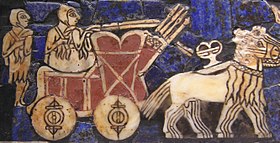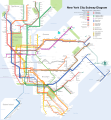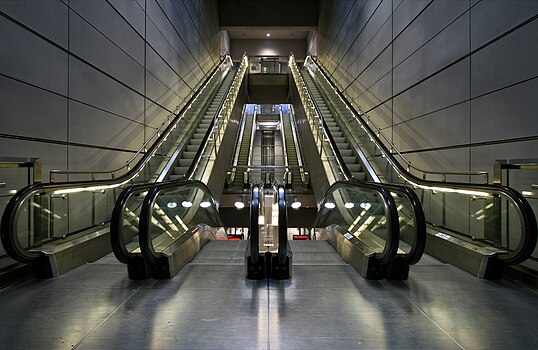Portal:Technology

Technology is the application of conceptual knowledge for achieving practical goals, especially in a reproducible way. The word technology can also mean the products resulting from such efforts, including both tangible tools such as utensils or machines, and intangible ones such as software. Technology plays a critical role in science, engineering, and everyday life.
Technological advancements have led to significant changes in society. The earliest known technology is the stone tool, used during prehistoric times, followed by the control of fire, which contributed to the growth of the human brain and the development of language during the Ice Age. The invention of the wheel in the Bronze Age allowed greater travel and the creation of more complex machines. More recent technological inventions, including the printing press, telephone, and the Internet, have lowered barriers to communication and ushered in the knowledge economy. (Full article...)
Recognized articles -
-
Business M-32 in Hillman at 0.738 miles (1.188 km), which is about 32 feet (9.8 m) longer.)
M-212 was assigned on December 29, 1937, from the intersection with Second Street to an intersection with US Highway 23 (US 23). In 1940, the state of Michigan rerouted US 23 and replaced it with M-33. (Full article... -
The Kawasaki Heavy Industries C151 is the first generation electric multiple unit (EMU) rolling stock in operation on the North–South and East–West lines of Singapore's Mass Rapid Transit (MRT) system, manufactured by a consortium led by Kawasaki Heavy Industries (KHI) under Contract 151. They were first introduced in 1987 and are the oldest trains in operation on the network.
Sixty-six trainsets consisting of six cars each and a single money train set consisting of four cars were contracted in 1984. They were manufactured from 1986 to 1989 in two batches by a Japanese consortium consisting of the namesake Kawasaki, Nippon Sharyo, Tokyu Car Corp and Kinki Sharyo following a round of intense competitive bidding by international rolling stock manufacturers. (Full article...) -
half diamond interchange in 2010. (Full article...)
-
town of Webster. NY 250 passes through the villages of Fairport and Webster, where it meets NY 31F and NY 104, respectively. The highway is the easternmost north–south state route in Monroe County.)
Most of the highway was taken over by the state of New York in the 1910s and 1920s. In 1908, the section of modern NY 250 in Fairport between Church and High Streets became part of Route 20, an unsigned legislative route assigned by the New York State Legislature. The definition of the route was altered in 1921, taking the route on a more southerly course that used the portion of what is now NY 250 between NY 31 and NY 31F instead through eastern Monroe County. NY 250 was assigned to its current alignment as part of the 1930 renumbering of state highways in New York. (Full article... -
US-164 in its entirety; that designation was then retired. (Full article...)
-
state-owned enterprise in April 1989. Vietnam Airlines is headquartered in Long Biên district, Hanoi, with hubs at Noi Bai International Airport in Hanoi and Tan Son Nhat International Airport in Ho Chi Minh City. The airline flies 117 routes across 19 countries, excluding codeshared services.)
From its inception until the early 1990s, Vietnam Airlines was a minor carrier within the aviation industry as it was hampered by a variety of factors including the socio-economic and political situation of the country. With the government's normalization of relations with the United States, the airline was able to expand, improve its products and services, and modernize its ageing fleet. In 1996, the Vietnamese government brought together 20 service companies to form Vietnam Airlines Corporation, with the airline itself as the centrepiece. In 2010, the corporation was restructured into a limited liability company and renamed Vietnam Airlines Company Limited. A seven-seat management board, members of which are appointed by the Vietnamese Prime Minister, oversees the company. (Full article... -
Selected picture
-
track. It is the busiest rapid transit rail system by annual ridership in the Western Hemisphere, and fifth busiest in the world. Its stations are located throughout the boroughs of Manhattan, Brooklyn, Queens and the Bronx. Staten Island has its own rail line which is not part of the system, but is included in the map as well.telecommunications device that converts sound, typically the human voice, into electronic signals suitable for transmission via cables or other transmission media over long distances through satellite.computer at the segregated West Area Computing division, she later took advanced engineering classes and, in 1958, became NASA's first black female engineer.
After 34 years at NASA, Jackson had earned the most senior engineering title available. Realizing that she could not earn further promotions without becoming a supervisor, she accepted a demotion to become a manager of the Federal Women's Program in the NASA Office of Equal Opportunity Programs, as well as of the Affirmative Action Program. In this role, she worked to influence both the hiring and promotion of women in NASA's science, engineering and mathematics careers. She was portrayed by Janelle Monáe as a lead character in the 2016 film Hidden Figures. This picture, taken in 1980, shows Jackson working at NASA Langley.material handling equipment cannot go.Bernina railway.Photograph: Diego DelsoThe Assut de l'Or Bridge is a white single-pylon cable-stayed bridge in the City of Arts and Sciences, Valencia, Spain. Completed in 2008, it was designed by Valencian architect and civil engineer Santiago Calatrava as a variant of his cantilever spar cable-stayed bridge in Seville.3D computer graphics software. Blender can be used for a number of applications and is available for a wide variety of operating systems.sixth generation video game console released by Nintendo beginning in 2001. Meant as a successor to the Nintendo 64, the GameCube sold approximately 22 million units worldwide. It was the third most-successful console of its generation, behind Sony's PlayStation 2 and Microsoft's Xbox. The GameCube was succeeded by the Wii in 2006.cylinder locks, but may also be found in tubular or radial locks.
When the correct key is inserted, the gaps between the key pins (red) and driver pins (blue) align with the edge of the plug (yellow).Class I railroad.Diagram credit: AstroBidulesThe Soyuz MS is the latest revision of the Russian spacecraft series Soyuz. It is an evolution of the Soyuz TMA-M, with modernization mostly concentrated on its communications and navigation subsystems. The spacecraft is used by Roscosmos for human spaceflight. The Soyuz MS has minimal external changes with respect to the Soyuz TMA-M, mostly limited to antennas and sensors, as well as the thruster placement. The first launch, Soyuz MS-01, took place on 7 July 2016 aboard a Soyuz-FG launch vehicle towards the International Space Station. This exploded-view diagram illustrates and labels various components of the Soyuz MS spacecraft and the Soyuz-FG rocket.Image credit: Prolineserver/TomiaThis diagram of four pulley systems illustrates how increasing the number of pulleys increases the mechanical advantage, making the load easier to lift. MA is the factor by which a mechanism multiplies the force put into it. In this diagram, 100 newtons is required to lift the weight off the ground. Each additional pulley increases the MA such that the four-pulley system only needs 25 newtons to accomplish the same task, but the rope must be pulled four times as far.laptop computer intended to be distributed to children in developing countries.Ruby Loftus Screwing a Breech Ring is a 1943 painting by the British painter Laura Knight depicting a young woman, Ruby Loftus (1921–2004), working at an industrial lathe as part of the British war effort in World War II. The painting was commissioned by the War Artists' Advisory Committee, and is now part of the Imperial War Museum's art collection. The painting brought instant fame to Loftus, and has been likened to the American figure of "Rosie the Riveter".Wiesen, Switzerland. Designed by Henning Friedrich, then the chief engineer of the Rhaetian Railway, it was built between 1906 and 1909 by the contractor G. Marasi (Westermann & Cie, Zürich) under the supervision of P. Salaz and Hans Studer (RhB). The Rhaetian Railway still owns and uses the viaduct today for regular service with 29 passenger trains per day. An important element of the Davos–Filisur railway, the viaduct is 88.9 metres (292 ft) high, 210 metres (690 ft) long, and has a main span of 55 metres (180 ft). In 1926, the viaduct was the inspiration for Ernst Ludwig Kirchner's painting Brücke bei Wiesen.distribution to transmit electrical energy along large distances. It consists of one or more conductors suspended by towers or utility poles.A wheel is a circular component that is intended to rotate on an axial bearing. The wheel is one of the main components of the wheel and axle which is one of the six simple machines.Main topics
General images -
The following are images from various technology-related articles on Wikipedia.-
TheGutenberg press was voted the most important invention of the second millennium. (from Invention)
-
3D printer (from Emerging technologies)
-
Newcomen steam engine for pumping mines (from History of technology)
-
A late Bronze Age sword or dagger blade (from History of technology)
-
A water-poweredmine hoist used for raising ore, ca. 1556 (from History of technology)
-
'BUILD YOUR OWN TELEVISION RECEIVER.'Science and Invention magazine cover, November 1928 (from Invention)
-
Design for a flying machine (c.1488) byda Vinci (from History of technology)
-
Clock from Salisbury Cathedral, ca. 1386 (from History of technology)
-
Self-replicating 3D printer (from Emerging technologies)
-
The wheel, invented sometime before the 4th millennium BC, is one of the most ubiquitous and important technologies. This detail of the "Standard of Ur", c. 2500 BCE., displays a Sumerian chariot. (from History of technology)
-
Dome of Florence Cathedral (from History of technology)
-
A rare 1884 photo showing the experimental recording of voice patterns by a photographic process at the Alexander Graham Bell Laboratory in Washington, D.C. Many of their experimental designs panned out in failure. (from Invention)
-
Edison electric light bulbs 1879–80 (from History of technology)
-
A variety of stone tools (from History of technology)
-
Thomas Edison with his second phonograph, photographed by Levin Corbin Handy in Washington, April 1878 (from History of technology)
-
Eric M. C. Tigerstedt (1887–1925) was known as a pioneer of sound-on-film technology. Tigerstedt in 1915. (from Invention)
-
 Artificial intelligence (from Emerging technologies)
Artificial intelligence (from Emerging technologies) -
Pont du Gard in France, a Roman aqueduct (from History of technology)
-
Top 30 AI patent applicants in 2016 (from Emerging technologies)
-
The compartmented water wheel, here its overshot version (from History of technology)
-
The preserved Rocket (from History of technology)
-
Ford assembly line, 1913. The magneto assembly line was the first. (from History of technology)
-
electrical battery. Volta is recognized as an influential inventor. (from Invention)
-
Walls at Sacsayhuaman (from History of technology)
-
Agriculture preceded writing in the history of technology. (from History of technology)
Did you know (auto-generated) -

- ... that racing driver James Sofronas worked as a salesman for a technology company to buy the Nissan NX 2000 required for his first competitive race?
- ... that touch-screen technology, pay-at-the-pump, car phones, and Coca-Cola Cherry were shown at the 1982 World's Fair?
- ... that Małgorzata Kalinowska-Iszkowska was awarded a Polish Gold Cross of Merit for her work in information technology?
- ... that Guy Parmelin, now President of Switzerland, opened the study program of cyber security of the Lucerne School of Information Technology in 2018?
- ... that Mary Earle was born near Ben Nevis, and although she became a professor of food technology in New Zealand, she never forgot her Scottish roots?
- ... that OPTi Inc. won a patent suit against Applefor unauthorized use of "predictive snooping" technology?
- ... that Peter Corby's electric trouser press used technology designed for Concorde?
- ... that Thomas Hall made an electric train that received power from the rails on which it travelled instead of onboard batteries, a new technology at the time?
Top 10 WikiProject Technology popular articles of the month
-










































































